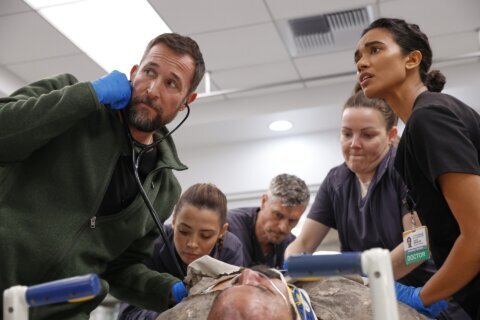This video is no longer available.
He became Pharaoh of Egypt in 1332 B.C. at the young age of nine before dying at age 18.
Now, King Tut is the subject of the new pop-up exhibition “Tutankhamun: His Tomb and His Treasures” at Rhode Island Center on Brentwood Road in Northeast D.C. from May 2 to July 31.
“It’s actually been touring Europe for the last 10 years, seven million people have seen it, and this is the first time that it’s in Washington D.C.,” curator Melinda Hartwig told WTOP. “It is the most comprehensive exhibition of replicas that has been done. The beauty of it is that you get the idea of context. You become an explorer as you go through the exhibition and you see things through the eyes of [Howard] Carter, the excavator.”
British archaeologist Howard Carter discovered King Tut’s tomb in the Valley of the Kings in Egypt on Nov. 4, 1922.
“Carter searched for many, many years,” Hartwig said. “The tomb of Tut was hidden because the tomb of Ramesses VI, roughly 200 years later, completely buried it underneath a lot of debris. Tut was considered to be an ephemeral king by the Egyptians, so we know that his tomb was robbed twice, but both robberies were interrupted so they didn’t get away with a lot of merchandise and that is why it’s so incredibly well preserved.”
The exhibition includes a replica of King Tut’s chariot, crafted with a mixture of bent wood and gold foil.
“This is the Chariot of State,” Hartwig said. “Think of this as Tut’s Maserati, where he would go amongst the people and show himself as [what he believed to be] a semi-divine king.”
Visitors will also see replicas of Tut’s thrones, which increase in size to show him aging into adolescence.
“You have a throne here made of ebony and ivory,” Hartwig said. “You see how small it is? This is where Tut’s bottom would have sat when he was a young boy being groomed to become a pharaoh. Progressively, we see the thrones get larger as we move along.”
Egyptians went to great lengths to protect King Tut’s remains. Tut’s mummified body was placed inside a solid-gold coffin, which was nested inside two larger gold coffins. That stack of coffins was then placed inside a large stone sarcophagus, which itself went inside of four giant gold shrines of increasing sizes.
“The important thing was to protect the body of the king, because when the king died, he became divine,” Hartwig said. “[In order to] join the cycle of the sun, the important thing was that he would be intact to do so. If he couldn’t, and anything happened to the body, Egypt could sink into chaos, so everything is an insurance policy.”
The grand finale is the famous golden mask placed over his mummified head.
“The most iconic object is the gold mask of Tut,” Hartwig said. “The beauty of replicas is that they are here to educate. To the untrained eye, it is impossible to find mistakes, these are almost near perfect. These were done by modern Egyptian craftsman in fine-art Cairo. They started, first of all, with a model in plaster, then covered it in resin, and then they would add glass applicants or some kind of alloy to create what you see here.”
From start to finish, the exhibition continues to fascinate historians centuries later.
“The tomb of Tutankhamun simply captured the world’s imagination,” Hartwig said. “It is one of the greatest archaeological discoveries of all time. … I love anything having to do with Ancient Egypt. You never know enough, there’s always something more to be learned and it’s part of our cultural heritage, it’s part of our humanity, so to understand Ancient Egypt is to understand the past.”
Get breaking news and daily headlines delivered to your email inbox by signing up here.
© 2024 WTOP. All Rights Reserved. This website is not intended for users located within the European Economic Area.








